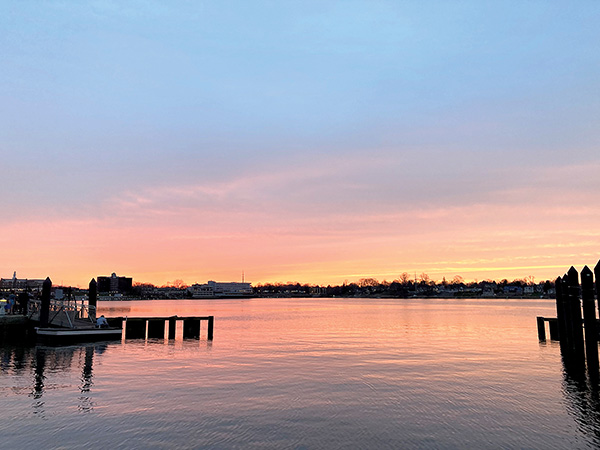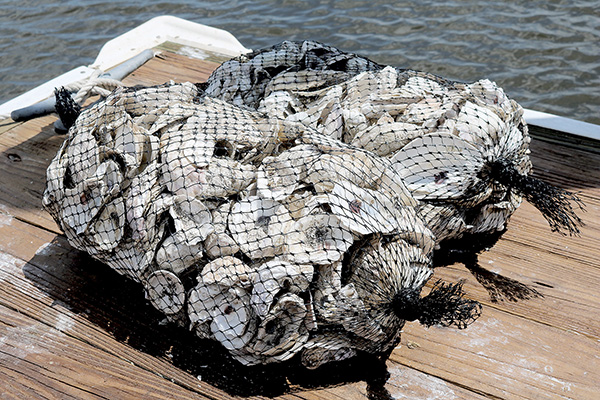By Allison Perrine

Conservation groups in the Two River area are working on initiatives that will preserve the area’s waterways and shorelines.
MONMOUTH COUNTY – At a time when many municipalities are experiencing development and change, local conservation groups know just how important it is to simultaneously preserve open space and water quality. That’s why throughout the past year, some local groups took on projects to maintain natural elements in the Two River area and beyond.
AMERICAN LITTORAL SOCIETY
According to Tim Dillingham, executive director of the Highlands-based Littoral Society, in 2021 the coastal conservation nonprofit made great strides with its “Shuck It Don’t Chuck It” oyster shell recycling program. Supported by The Lusty Lobster in Highlands and a grant from the Marta Heflin Foundation, the program enables Littoral Society members to collect used oyster shells from local restaurants and recycle them to address water quality issues in waterways, including in the Navesink and Shrewsbury rivers.
“Oysters are ecosystem engineers,” said Dillingham. Each oyster can filter up to 50 gallons of water per day. To put it simply, they “take out some of the nasty stuff that we as a society allow to get into our bays and coastline,” said Dillingham.
Once the oyster shells – which would normally end up in a landfill after the meat is consumed – are collected, they are hauled off to Sandy Hook where they sit out in the open for anywhere from six months to a year to ensure there’s no remaining bacteria on the shells before they are repurposed. Then they can be recycled back into the waterways to help grow new oysters, where they will clean the water and build themselves into reefs which helps protect other marine life. That’s why having more of these salt water mollusks in the Two River area is “a win-win for oyster lovers, businesses and the bay’s waters,” according to the Littoral Society.
“Ultimately, our goal with this work is to help clean up New Jersey’s waters and to restore the bounty of marine life that has been there in the past,” he said.
In years past, Littoral Society members have held Oyster Day events at Forrestdale School in Rumson where students learned “all things oyster,” Dillingham said, including the biology and history of oysters, the ecological role they play and more. He hopes to return this program to schools in 2022 and introduce ones about beach grass and other marine habitats, if the status of the COVID-19 pandemic allows.
Another goal for 2022 includes rebuilding some shorelines in southern Monmouth County including Deal and Sylvan lakes which were impacted by collapsed bulkheads and “hard structures” that, in some cases, date back to Super Storm Sandy. The goal is to replant them with marsh grasses “and other things that are natural as opposed to these hard structures which really destroy the ecology of the lakes,” said Dillingham.
And its work won’t end there. Plans are now in the works to address grander challenges such as climate change, coastal resiliency and sea level rise which could result in more intense future storms.
“We’ve been doing a lot of work researching… the best practices – what’s going to work best, what’s going to provide not only community benefits in mitigating some of the hazards but improving the ecology of the bays and the shoreline,” said Dillingham. “I imagine that will be a big focus in 2022.”
Much of the organization’s work is done in partnership with local municipalities, environmental commissions and other like-minded organizations. Volunteer opportunities are always available. Anyone interested in learning more can visit littoralsociety.org.
MONMOUTH CONSERVATION FOUNDATION

As part of an American Littoral Society initiative, restaurants donate shucked oyster shells to be repurposed in Two River waterways.
While American Littoral Society was working on water preservation, Monmouth Conservation Foundation (MCF) focused on the dryer parts of the area. In 2021, the nonprofit worked with municipalities on various initiatives throughout the county to increase the public’s access to parks, open space and farmland.
“We constantly look at partnerships where one nonprofit or one municipality can’t do it all and we pull together as partners and make it happen,” said William D. Kastning, MCF executive director. “All together we can make things happen which otherwise would not happen, especially in this real estate market.”
A major feat at the beginning of the year was the closure on a 35-acre property on Fort Plains Road in Howell Township, with collaboration by the MCF, township and state Green Acres Program. The wooded tract will become a dedicated passive park area, protected from development.
And it’s looking to be a busy year ahead with projects in mind for Fair Haven, Sea Bright, Middletown and other Two River areas. In Colts Neck alone, MCF hopes to preserve nearly 400 acres of open space, mostly through development easements, according to Jena Cosimo, director of acquisitions. Essentially, the nonprofit will buy the development rights to the identified properties through various programs, including the U.S. Department of Defense’s Readiness and Environmental Protection Integration (REPI) program.
As part this nationwide initiative, the DOD is making funding available to protect the resiliency of military installations; Naval Weapons Station Earle – which is partly located in Colts Neck – is one of them.
“We’re getting a taste of what they’re doing throughout the nation,” Cosimo said. “It’s going to be interesting to see how this all develops for us in Monmouth County. We’re hopeful that this will become a steady source of funding for us in the future as well.”
In total, MCF and the county have been awarded $2,065,070 from the REPI program to help protect the land around the base, which touches areas including Colts Neck, Howell, Wall, Tinton Falls and Leonardo as well as the Sandy Hook Bay. Part of its goal is to purchase development easements on properties within a 2-mile radius around the internal base, the military road and the pier, Cosimo said.
“They want to make sure that they protect land around Earle for various reasons,” she added, such as threats of forest fires. The $2-plus million in funding must be matched and spent within a five-year period. MCF hosted several fundraising events throughout the year and will continue to do so in 2022 to accomplish that goal.
In May, MCF held its Spring for Conservation event at Bayonet Farm in Holmdel after some downtime amid the initial wave of the COVID-19 pandemic. “We expected 100 people and we ended up with 300 people. Everybody was anxious to have some fun,” Kastning said.
With its success, the group continued to host a few more fundraisers throughout 2021, including its annual run in June, a Fall for Conservation event in September and, most recently, a holiday shopping spree event in December. Kastning called each of the events “highly successful” in that supporters had fun and the nonprofit was able to collect money to benefit its projects and operations costs. Donations are also welcomed by the nonprofit, and some generous community donors stepped up to help out. This fall an anonymous philanthropist donated $2 million to benefit an urban park in an underserved community. Kastning could not say which park it will be used for but did note an announcement will be made at some point.
Additionally, MCF executive committee member Gloria Nilson and her husband Len gave a $1 million gift to allow for the establishment of The Nilson Society, a planned giving program for MCF donors who provide for the nonprofit in their estate plans. Continuing to look toward 2022, MCF plans to move on construction for Swimming River Park in Middletown. The park, which overlooks the Navesink and Swimming rivers, is a more recent addition to the Monmouth County Park System and provides visitors with a popular public boat ramp as well as a place for fishing and crabbing.
Until recently, the COVID-19 pandemic caused some delays in the development of this passive recreation space which will likely include an improved boat ramp, walking paths, benches, a parking area and eventually, a memorial to honor MCF founder Judith Stanley Coleman.
“There should be some earth moving and actual park development in the new year, probably toward late winter/ spring,” said Cosimo. “Hopefully, that park will look a lot different come this time next year.”
Additionally, in Sea Bright, MCF will be working on a passive park project at the site of the former Anchorage Apartments next to the Rumson-Sea Bright bridge. The first phase is complete but the second phase is ongoing and will include more plantings on site, bike racks, benches and more. To date, MCF has helped raise about $167,000 for the improvements which will likely be completed in the spring.
“It will be a great park, considering what it used to be years ago when it was the apartment complex,” said Kastning. “Everybody is thrilled with it.”
Aside from often being aesthetically pleasing, Cosimo shared the many ways that open space is beneficial – whether it be to combat climate change, protect water quality, shelter wildlife, help farmers thrive or simply provide a space for people to enjoy nature.
“It was pretty evident with the COVID pandemic… everybody was stuck in their homes and the only real outlet anyone had was to get outside,” Cosimo said. “Our parks were more important than ever and I’m really hopeful that people can continue to realize that and recognize how important it is to continue to create new parks and protect our natural habitat.”
The article originally appeared in the January 1-6 2022, 2022 print edition of The Two River Times.














